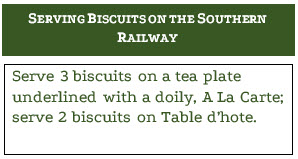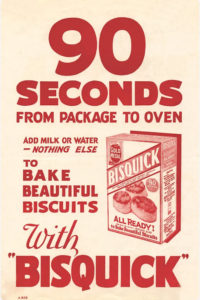Imagine you are a chef for an exclusive restaurant – except that your kitchen is only about four feet wide, you share it with other chefs, and it is moving. Chefs on railroads had to deal with all the above, plus strict oversight from the railroad itself.
Railroad companies had strict rules for their chefs to follow so all passengers would enjoy consistently excellent and fresh food.  For example, the railroads instructed chefs to make all food when ordered, but that can be tough in a small kitchen.
For example, the railroads instructed chefs to make all food when ordered, but that can be tough in a small kitchen.
The art of biscuit making is a perfect example. To make a good biscuit, a chef needs flour, baking soda, baking powder, salt, shortening, and water. Mix them all together, in the appropriate amounts, of course, and pop them in the oven until they are golden brown. One ingenious chef on Southern Pacific realized he could pre-mix all the dry ingredients and store them in the icebox. Then, when an order came in, he just added water and put them in the oven.
 In 1930, Carl Smith, a salesman for General Mills, asked the chef to make him something quick and easy and, in a few minutes, he had fresh, piping hot biscuits. Smith asked the chef how he made the biscuits so fast and then took the idea to General Mills, and Bisquick was born.
In 1930, Carl Smith, a salesman for General Mills, asked the chef to make him something quick and easy and, in a few minutes, he had fresh, piping hot biscuits. Smith asked the chef how he made the biscuits so fast and then took the idea to General Mills, and Bisquick was born.
General Mills later used the idea of pre-mixing dry ingredients for cake and muffin mixes also.
Ads are from General Mills website at www.generalmills.com
